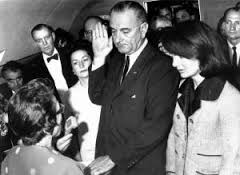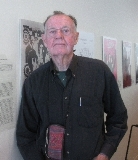Where Were You When John F. Kennedy Was Shot? Thomas Pleasure (Peru 1964-66) Remembers

LBJ Takes Oath of Office on plane
In June of ’63 I was so stoked by the President’s Peace Speech at American University that at my graduation from UCLA the following week, my fiancé and I submitted our applications to join the Peace Corps the Summer of ’64 when she graduated. Peace was coming and I wanted to be a veteran of making peace. I had already served my time in the military years before arriving at UCLA.
Upon graduating high school I had signed on with ATSF railroad as a switchman, albeit a grimy job it financed my college education and lots of adventuring. The jobs offered me after I graduated from UCLA: Bank Mgmt. Trainee $395 and Supermarket Product Sales $495, were half of what I earned as a Santa Fe switchman, a union job.
By the first week of November ’63 my buddies had convinced me I should take a White Collar job selling Dictaphones with them. Their arguments were simple: you wear coat and tie, colored shirt or white, and, best of all, your drinks at lunch were a business expense! As to pay, salesmen get an advance against their sales. How hard could it be to sell a furshluggin Dictaphone?
My territory was Hollywood. My first week was in-house equipment training, my second week was supervised by the District Mgr. On Friday afternoon, Gordon Kleinpeter, a tall lanky Bruin-educated salesman, burst into the office screaming, “The President has been shot in Dallas.”
I went into the bathroom so no one could see the tears of disappointment that surged through and out of me. One of the salesmen educated at neighboring USC was thrilled. “Great,” he announced, “I can play golf today and the course will be empty,” and promptly left.
I didn’t really know what to do with my anger. Who to strike out at, how to make things better? As any good Dictaphone trainee would do, I went in and asked Jack Van Pelt, the District Mgr., what did he want me to do for the rest of the day?
In a somber tone, Jack responded, “You really can’t make any cold calls today, but go visit some of your bigger clients. Let them see you.”
Gordie and I decided we should have a drink to think things threw. We went to the Olympian Bar at the corner of Olympic and Vermont, a few blocks from our office. The bar was dark, the junk box was playing sad Sinatra, and my reaction was, I need to get into a fistfight. Which, later, I deduced I had learned from the movies. When your leader gets killed, others must pay the price. I never found anyone that afternoon I could get into a fight with; I just got drunk.
December 10th Dictaphone’s VP of Marketing sent out to all its sales personnel the famous photo of LBJ being sworn in on Air Force One with a blood-stained Jackie standing next to him as a Dictaphone recorded the entire affair. Naturally, the VP explained, you couldn’t use this photo to sell machines but no doubt clients would like to know the President’s airplane is equipped with a Time-Master/6 Dictaphone.
I knew then I could never be a corporate cog.
Even more disappointing Dictaphone’s new P-7 dictating machine didn’t work. As soon as one was sold, it was out of sales’ hands and into service, so we technically didn’t have to deal with the problem of the machine not working. To keep our institutional clients happy, the sales force colluded with service personnel and we sold reconditioned P-6 machines as new ones, much below the price of a new P-7. At least the old machines worked.
The problem was that after the new machine failed it was fixed in service, recycled and sold as new. I sold new recycled machines that didn’t work to the Chairman of the Board of Max Factor and another one to a VP at Technicolor, the soon-to-become US Senator from California, George Murphy the actor. So how smart were these businessmen, I reasoned, if I could sell them a $400 machine that didn’t work?
I was deeply depressed by this fraudulent sales effort when Dictaphone’s VP of Sales came to LA to perk up the sales force and I asked him publicly at the Sales Meeting, “Why did you put out a machine that doesn’t work?”
“We had to meet the competition. IBM just introduced its magnetic tape recorders offering buyers an alternative to Dictaphone’s Blue Belt permanent recordings.” The old dog knew what he was talking about. The industry was shifting. Everyday you’d hear, ‘Dictaphone in your ear.”
The next month I broke my shin in two places skiing drunk and sold re-conditioned Dictaphones in Hollywood wearing shorts and a full-length cast. In April ’64 my fiancé and I rented an apartment in Santa Monica for our June marriage. Then, out of the blue, the Peace Corps invited us to a Rural Peru Community Development training program at Cornell University in upstate New York! The day before my June wedding the full-length cast was removed and after a five day NYC honeymoon I was in Peace Corps Training, running up and down the hills of Ithaca, learning the art of community action.
Because of my Dictaphone experience I knew that President Nixon’s accidentally erased Dictaphone Belt (not tape) of 17 minutes of crucial Watergate conversations was a total lie. Recording on Dictaphone’s famous ‘Blue Belt’ is akin to recording on a flexible record. You can’t record over, although using a screwdriver or a knife would destroy the Belt.
In 1978 when the House Select Committee on Assassinations re-investigated the murder of President Kennedy and the Warren Commission’s sole assassin conclusion, it was discovered that the Dallas Police Department’s Dictaphone recording system captured the sound of four shots because a motorcycle officer’s microphone had been stuck on ON. The HSCA concluded there were four shots, at least one coming from the grassy knoll, meaning crossfire, a conspiracy, a cover-up, an American coup d’ etat! Imagine the Crime of the 20th Century revealed by Dictaphone’s old-fashioned outmoded vinyl Blue Belt. The next time you hear ‘lone assassin,’ tell ’em to ‘Dictaphone in their ear.’
Thomas Pleasure, an RPCV who served in Peru 1964-66, has been a lifelong blue-collar social activist & critic, travel writer, and Venice Beach calendar publisher. His work has appeared in the Los Angeles Times, SF SundayExaminer/Chronicle, Seattle-Post Intelligencer, The New Mexican, California and other publications.
& critic, travel writer, and Venice Beach calendar publisher. His work has appeared in the Los Angeles Times, SF SundayExaminer/Chronicle, Seattle-Post Intelligencer, The New Mexican, California and other publications.
No comments yet.
Add your comment